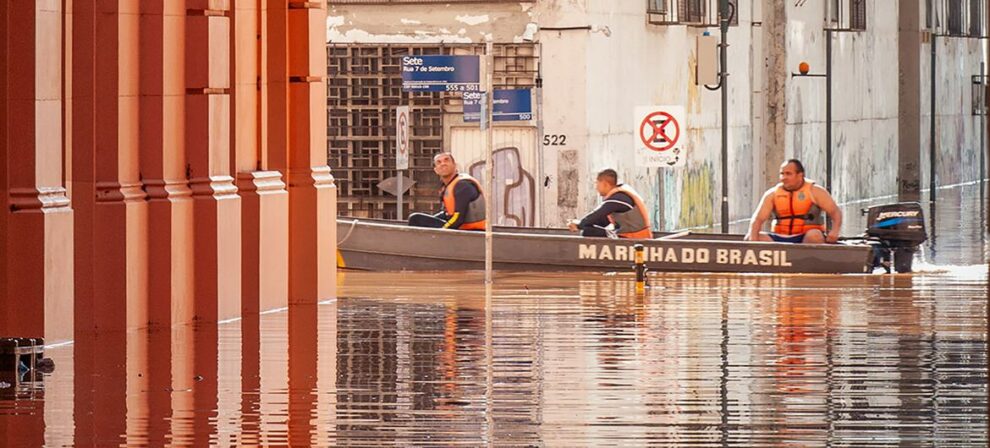The torrential rains that have hit southern Brazil since the end of April causing river flooding in the state of Río Grande del Sur have caused flooding in cities and densely populated areas, leaving more than a hundred dead, many others missing and injuring more than 1.7 million people.
The UN Refugee Agency (UNHCR) works with federal, state and municipal authorities, as well as humanitarian organizations in Brazil to mitigate the serious impact of these extreme weather events largely due to climate change and exacerbated by the current El Niño episode.
To date, official figures show 107 dead and 134 missingin addition to considerable material losses.
The UNHCR spokesperson in Geneva explained that the agency’s staff collaborates with the authorities in evaluating the needs of the affected population and in input distribution of help such as blankets and mattresses to alleviate the cold and winds of the southern autumn.
Among the victims there are some 41,000 refugees
At a press conference, William Spindler indicated that those affected include some 41,000 refugees and other people in need of international protection, including many Venezuelans and Haitians who live in disaster areas, some of which can only be reached by boat.
According to government data, more than 21,000 Venezuelans live in Río Grande del Sul who were relocated there in April 2018 from the state of Roraima, on the country’s northern border with Venezuela.
Given the isolation of many communities, UNHCR provides technical support to facilitate communications and give refugees and migrants access in their language to official information on protection recommendations and risks in the places where they live.
Floods in the historic center of Porto Alegre, in Rio Grande do Sul, Brazil.
Issuance of documents
In the coming days, the Agency will help with the issuance of documents for cases in which these have been lost or damaged.
The intention is to “ensure that refugees and asylum seekers continue accessing social benefits and public services“Spindler detailed.
The UN agency also collaborates with local civil society teams that offer psychological assistance and respond to the most vulnerable cases among both refugees and host communities.
It is also sending additional relief supplies, such as emergency shelters, kitchen sets, blankets, solar lamps and hygiene kits, to Brazil from its regional and northern Brazilian stockpiles.
Extreme weather events in Brazil have been frequent and more devastating in recent years, including droughts in the Amazon region and heavy rains in the states of Bahia and Acre.
UNHCR estimates that there is a need $3.21 million to meet the most urgent needs, including direct financial assistance to affected people and provision of essential relief items.
More than 85% of the territory of Rio Grande do Sul suffers from floodingwhich have forced some 68,000 people to live in makeshift shelters, while more than 327,000 have abandoned their homes.
The rains will continue
Meteorologists have warned of more heavy rain accompanied by strong winds throughout the state until this weekend.
UNHCR recalled that serious climate phenomena disproportionately affect refugees and other people who request international protection and who have insufficient resources to alleviate the needs of the displaced and the communities that host them.
“Without help to prepare for, resist and recover from climate-related shocks, they face increased risk of further displacement,” Spindler said.
In April 2024, UNHCR launched its first Climate Resilience Fund with the goal to increase the resilience of refugeesdisplaced communities and their hosts in the face of the increasing intensity of extreme weather events related to climate change.

Rescue workers navigate flooding in the historic center of Porto Alegre, Rio Grande do Sul, Brazil.
The rain of more than two months falls in three days
This week, the World Meteorological Organization (WMO) noted that the disaster in Brazil, like the floods in East Africa, highlight the need for a more integrated response to the El Niño phenomenon and the impacts of climate change
Likewise, he stressed the urgency of establishing systems of early warning for the entire population.
The WMO detailed that in some Brazilian regions, especially in the broad central valleys, plateaus, mountain slopes and metropolitan areas, Rain volumes exceeded 300 millimeters in less than a weekciting the extreme case of the municipality of Bento Gonçalves, which reached 543.4 mm of water.
Porto Alegre, for its part, received 258.6 mm of rain in just three days, an amount that corresponds to more than two months of rain.
The WMO added that the period between the end of April and the beginning of May 2024 experiences the influence of El Niño and that this phenomenon, responsible for the warming of the waters of the Pacific, contributed to blocking cold fronts and concentrating the systems of areas of instability over Rio Grande do Sul.


![[Img #74664]](https://thelatestnews.world/wp-content/uploads/2024/12/James-Watson-The-controversial-genius-behind-the-double-helix-150x150.jpg)











Add Comment